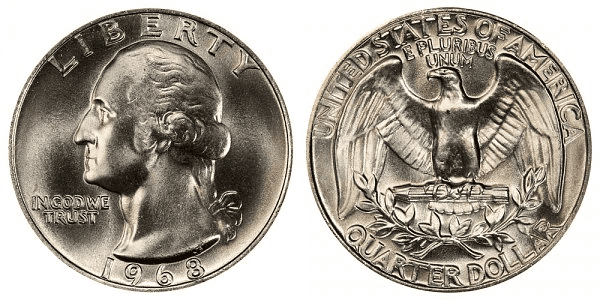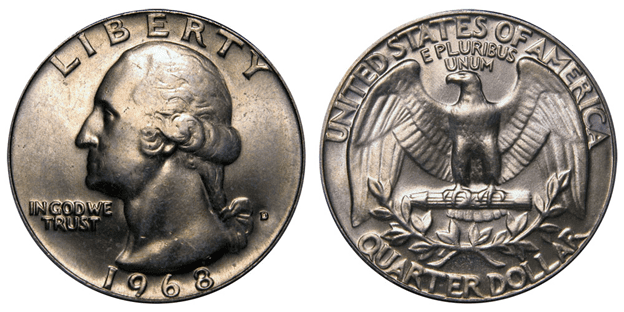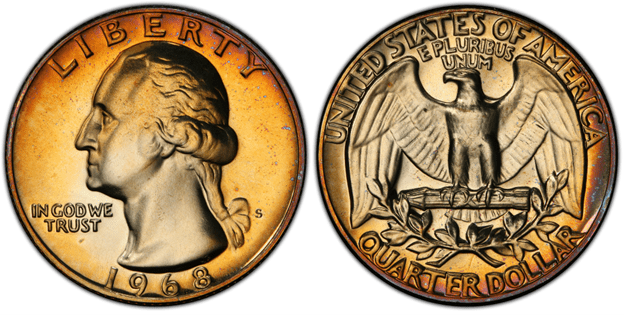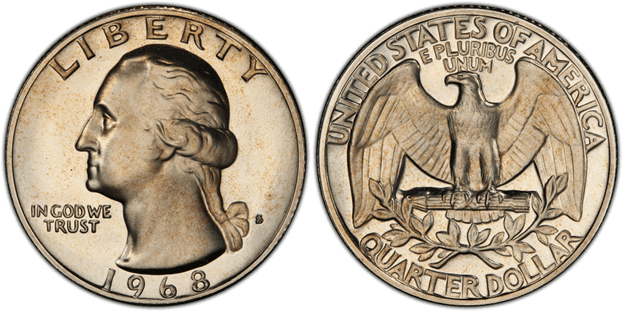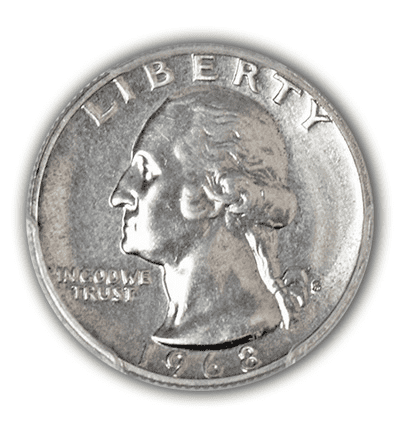What Is A 1968 Quarter Made Of?
Earlier Washington Quarters had a silver composition, but starting in 1968, the quarters had a 91.67% Copper center and 8.33% Nickel cladding. John Flanagan based his left-facing likeness of George Washington on Jean-Antoine Houdon’s 1786 bust for the coin’s obverse.
LIBERTY is written around the top of the coin and above Washington’s hair. The year “1968” is etched around the bottom of the George Washington bust, which has been shortened. To the left of Washington is the national motto, IN GOD WE TRUST.
The reverse of the coin features a sheaf of arrows resting on an eagle with a heraldic design in the Art Deco style. The arrows and the eagle’s head both point to the left. Two olive branch sprays are arranged in the shape of a U around the bottom of the eagle. Around the top of the coin are the words the UNITED STATES OF AMERICA.
Below it is the motto E PLURIBUS UNUM. The base of the coin is inscribed with the text “QUARTER DOLLAR.” The edge of the 1968 Washington quarter is reeded.
1968 saw the first flight of Boeing’s 747 jumbo jet while NASA’s Apollo 8 was in lunar orbit. Two peace campaigners, Martin Luther King Jr., and Robert F. Kennedy, were killed and Navy intelligence ship USS Pueblo was sunk.
How To Differentiate Between Clad And Silver 1968 Quarters?
While the intention was that by 1968 all quarters would be made without a silver content, mistakes do happen, and there are occurrences of 1968 quarters being struck in the silver composition seen in previous coins. These errors are worth thousands, so being able to tell the difference between a standard 1968 quarter, and a rare silver example, is pretty important!
How would you recognize a silver quarter? It’s easy. The simplest technique is to use a calibrated gram scale to weigh the coin. The weight of the 90% silver quarters is 6.25 grams, compared to the normal clad quarters’ 5.67 grams. The eye test is another option. Silver quarters have a glossier surface and no copper or nickel layers that protrude from the coin’s edge.
1968 Quarter Varieties
1968 Quarter With No Mint Mark
Year: 1968
Face Value: $0.25
Composition: 91.67% Copper and 8.33% Nickel
Total Weight: 5.67g
Diameter: 24.3 mm
Thickness: 1.95 mm
Edge: Reeded
Minted in: Philadelphia
Quantity Minted: 220,731,500

photo source: www.usacoinbook.com
1968 D Quarter
Year: 1968
Face Value: $0.25
Composition: 91.67% Copper and 8.33% Nickel
Total Weight: 5.67g
Diameter: 24.3 mm
Thickness: 1.95 mm
Edge: Reeded
Minted in: Denver
Quantity Minted: 101,534,000

photo source: www.usacoinbook.com
1968 S Proof Quarter
Year: 1968
Face Value: $0.25
Composition: 91.67% Copper and 8.33% Nickel
Total Weight: 5.67g
Diameter: 24.3 mm
Thickness: 1.95 mm
Edge: Reeded
Minted in: San Francisco
Quantity Minted: 3,041,506

photo source: www.pcgs.com
List of errors
1968-S Deep Cameo
Not an error, but certainly worth looking out for. Black and white cameos are another name for deep cameos, which are coins—typically proofs and proof-like coins—with highly frosted designs and inscriptions that contrast with the fields.
Put simply, the contrast between the raised elements and the background is greater and crisper than typical coins leading to a clearer and more impressive strike. Deep cameos coins in good condition can reach up to $900 in value.

photo source: www.pcgs.com
1968-S Proof Quarter, Struck on a 90% Silver Planchet

photo source: coinweek.com
This is an exceptionally rare example of a 1968 Washington quarter. This quarter has been struck on a planchet meant for the pre-1965 silver Washington quarters and uses the old silver/copper composition. It is the only known example of its kind.
This coin, which is currently graded PCGS PR64, was bought at the September 2017 Long Beach Expo. It comes with a letter from July 1969 that has a spectrograph examination proving its composition to be 90% silver and 10% copper.
1968 Doubled Die Quarter Error
The 1968 doubled die quarters are extremely valuable, yet they can be hard to come by. A few famous doubled dies from 1968 are known to exist; they can usually be identified by the wording on the coins being doubled. You’ll need a decent coin magnifier to recognize the 1968 doubled die quarters because they are more difficult to distinguish than some of the more extreme doubled dies.
A 1968 doubled die quarter error often sells for between $50 and $100, and occasionally even more.
1968 Off-Center Quarter Error
Depending on how much of the coin’s design is gone and which parts are still visible, the off-center quarter faults can be very valuable. A 1968 quarter with 15%–30% of its design lost is easily worth $50–100. A 1968 quarter that is lacking roughly 50% of its design but still displays the entire date can be worth up to $200 or even more!
1968 Broadstrike Quarter Error
A 1968 quarter with rim flaws or a smooth edge without ridges may be quite valuable. Of the 1968 rim mistake quarters, the broadstrike, which was struck without a collar, is arguably the most renowned and valuable (the device that helps form the rim and create ridges on the edge of a coin).
Broadstrike faults are broader and typically thinner than regular quarters, but they display their entire pattern. However, be careful to keep it if you do come across a 1968 broadstrike quarter error. Depending on the coin’s condition and the size of the broadstrike fault, many 1968 quarters with the error are worth between $20 and $50.
How Much Is A 1968 Quarter Worth Today?
The melt value of a 1968 quarter is a pitiful $0.052, implying that any value (beyond the face value) perceived in this currency derives from factors like condition, mistakes, and provenance. Since this coin contains no precious metal, it has no melt value.
Since these coins are still in use, their primary value, aside from rarities, is determined by their condition, with the exception of MS grade coins, which are only worth their face value.
| Coin | G | VG | F | VF | MS60 | MS65 | PR |
| 1968-P | – | – | – | – | – | $9.13 | – |
| 1968-D | – | – | – | – | – | $6.55 | – |
| 1968-S (Proof) | – | – | – | – | – | – | $4.52 |
How Does The Grading System Work?
The Sheldon Scale is used by numismatists to provide a numerical value to coins. The Sheldon Scale goes from poor (P-1) to perfect mint state (P-1) (MS-70). Coins were originally evaluated using words to reflect their condition (Good, Fair, Excellent, Etc.). Unfortunately, coin collectors and dealers had different ideas about what each of these terms represent.
Professional numismatists joined together in the 1970s and established CoinGrading standards. These numismatists now assign grades at key places on the seventy-point scale, using the most regularly utilized numeric points in conjunction with the original adjective grade. The following are the most common coin grades:
-
-
- (P-1) Poor – Indistinguishable and probably damaged; if used, must have a date and mintmark; otherwise, rather battered.
- (FR-2) Fair – Nearly smooth, but without the damage that a coin graded Poor often possesses. The coin must have enough detail to be identified.
- (G-4) Fair – Inscriptions have merged into the rims in some areas, and important elements have been mostly erased.
- (VG-8) Very Good- A little weathered, but all of the primary design elements are visible, albeit faintly. There is little if any, central detail left.
- (F-12) Good – The item is very worn, yet the wear is even, and the overall design details stand out clearly. Rims are almost completely isolated from the field.
- (VF-20) Very Fine – Moderately weathered, with some finer features still visible. The motto or all letters of LIBERTY are readable. Both sides of the coin have entire rims that are separated from the field.
- (EF-40) Extremely Fine – Gently used; all gadgets are visible, and the most important ones are bold. The finer details are bold and clear, however, light wear may be seen.
- (AU-50) Uncirculated – Slight evidence of wear on the coin’s design’s high points; may have contact marks; eye appeal should be adequate.
- (AU-58) Uncirculated Choice – Slight traces of wear, no severe contact marks, almost full mint shine, and great eye appeal.
- (MS-60) Mint State Basal – Strictly uncirculated; no indication of wear on the coin’s highest points, but an unsightly coin with reduced luster, visible contact marks, hairlines, and other flaws.
- (MS-63) Mint State Acceptable – Uncirculated, but with contact scratches and nicks, little reduced shine, but otherwise appealing appearance. The strike is weak to average.
- (MS-65) Mint State Choice – Uncirculated with great mint shine, very little contact blemishes, and exceptional eye appeal. The strike is unusually severe.
- (MS-68) Mint State Premium Quality – Uncirculated with superb luster, no obvious contact marks to the naked eye, and exceptional eye appeal. The strike is quick and appealing.
- (MS-69) Almost Perfect Mint State – Uncirculated with perfect brilliance, a sharp and appealing strike, and extremely good eye appeal. A near-perfect coin with minor imperfections in the planchet, strike, and contact markings (seen only under 8x magnification).
- (MS-70) Mint State Perfect – Under 8x magnification, there are no tiny imperfections discernible; the strike is crisp, and the coin is perfectly centered on a beautiful planchet. Rarely seen on a coin, this coin is bright and whole, with original luster and exceptional eye appeal.
-
Where To Buy Or Sell 1968 Quarters?
When it comes to 1968 quarters, there’s plenty to look out for, so if you have one in your possession it might be worth looking at it under a microscope to check for any errors or special features before you consider selling. Regular 1968 quarters can be bought or sold for a few bucks at places like Etsy and eBay.
If you think you might have something special, but you’re not sure, you could post up an image in a coin collectors forum for some answers from fellow collectors.
When it comes to buying and selling rare examples of 1968 quarters, sticking to legitimate specialist sellers such as Heritage Auctions can help you to avoid scams.
FAQs
What is the melt value of a 1968 Canadian quarter?
As it is made from 92.5% silver, the 1968 Canadian quarter has a melt value of around $3.33.
What does it mean when there is no mint mark on a coin?
Unless highlighted in coin collecting communities as a rare error, coins without a mint mark have been struck in Philadelphia, who have never punched a mint mark onto the coins they produced.
Where is the mint mark located on a 1968 quarter?
The mint mark on 1968 quarters can be found on the obverse side of the coin to the right of Washington’s ponytail.
How much is a 1968 coin set worth?
Without special coins, a 1968 set of coins is worth under $10.

